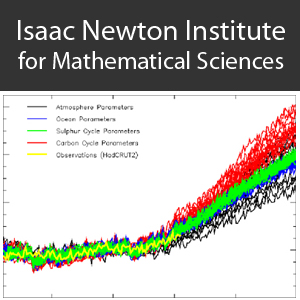A very grand challenge for the science of climate prediction
Duration: 1 hour 10 mins 44 secs
Share this media item:
Embed this media item:
Embed this media item:
About this item

| Description: |
Palmer, T (ECMWF)
Monday 23 August 2010, 10:00-11:00 |
|---|
| Created: | 2010-08-24 13:07 | ||||
|---|---|---|---|---|---|
| Collection: | Mathematical and Statistical Approaches to Climate Modelling and Prediction | ||||
| Publisher: | Isaac Newton Institute | ||||
| Copyright: | Palmer, T | ||||
| Language: | eng (English) | ||||
| Distribution: |
World
|
||||
| Credits: |
|
||||
| Explicit content: | No | ||||
| Aspect Ratio: | 16:9 | ||||
| Screencast: | No | ||||
| Bumper: | UCS Default | ||||
| Trailer: | UCS Default | ||||
| Abstract: | A rather prevelant picture of the development of climate models throughout the 20th Century, is for the idealised, simplified, and hence mathematically tractable models of climate to be the focus of mathematicians, leaving to engineers, the "brute force" approach of developing ab initio Earth System Models. I think we should leave this paradigm in the 20th Century, where it belongs: for one thing, the threat of climate change is too important and the problems of predicting climate reliably too great. For the 21st Century, I propose that mathematicians need to engage on innovative methods to represent the unresolved and poorly resolved scales in ab initio models, based on nonlinear stochastic-dynamic methods. The reasons are (at least) threefold. Firstly, climate model biases are still substantial, and may well be systemically related to the use of deterministic bulk-formula closure - this is an area where a much better basic understanding is needed. Secondly, deterministically formulated climate models are incapable of predicting the uncertainty in their predictions; and yet this is a crucially important prognostic variable for societal applications. Stochastic-dynamic closures can in principle provide this. Finally, the need to maintain worldwide a pool of quasi-independent deterministic models purely in order to have an ad hoc multi-model estimate of uncertainty, does not make efficient use of the limited human and computer resources available worldwide for climate model developement. The development of skilful stochastic-dynamic closures will undermine the need for such inefficient use of human resources. As such, a very grand challenge for the science of climate prediction is presented in the form of a plea for the engagement of mathematicians in the development of a prototype Probabilistic Earth-System Model. It is hoped that this Newton Institute Programme will be seen as pivotal for such development. |
|---|---|
Available Formats
| Format | Quality | Bitrate | Size | |||
|---|---|---|---|---|---|---|
| MPEG-4 Video | 640x360 | 1.84 Mbits/sec | 980.28 MB | View | Download | |
| WebM | 640x360 | 2.05 Mbits/sec | 1.05 GB | View | Download | |
| Flash Video | 484x272 | 573.52 kbits/sec | 297.41 MB | View | Download | |
| iPod Video | 480x270 | 510.91 kbits/sec | 265.00 MB | View | Download | |
| MP3 | 44100 Hz | 125.0 kbits/sec | 64.64 MB | Listen | Download | |
| Auto * | (Allows browser to choose a format it supports) | |||||

